Early Triassic Monzonite–Granite Series in Eastern Kazakhstan as a Reflection of Siberian Large Igneous Province Activity
Abstract
:1. Introduction
2. Geological Background
3. Semeitau and Delbegetei Massifs—Geological Structure
4. Materials and Methods
5. Results
5.1. Petrography of Rocks
5.2. Zircon U-Pb Geochronology
5.3. Major and Trace Element Geochemistry
6. Discussion
6.1. Former Opinions
6.2. Petrogenesis of Igneous Rocks
6.3. The Age of Massifs
6.4. Geodynamic Setting
7. Conclusions
- The synchronous formation in the early Triassic of the Semeitau and Delbegetei massifs in Eastern Kazakhstan, which were previously considered to be of different ages, has been proven.
- Both massifs are composed of rocks of the same monzonite–granite series of rocks. The formation of this series is the result of the interaction of mafic magmas with crustal melts formed during the melting of terrigenous substrates.
- Analysis of the geological position, age and composition of the rocks allows us to conclude that the Semeitau and Delbegetei massifs were formed in an intraplate geodynamic setting. The activity of the mantle plume is the most probable reason for their formation.
- The Semeitau and Delbegetei massifs can be included in the Early Triassic Siberian large igneous province.
Supplementary Materials
Author Contributions
Funding
Data Availability Statement
Acknowledgments
Conflicts of Interest
References
- Bryan, S.E.; Ernst, R.E. Revised definition of Large Igneous Provinces (LIPs). Earth-Sci. Rev. 2008, 86, 175–202. [Google Scholar] [CrossRef]
- Ernst, R.E.; Buchan, K.L.; Campbell, I.H. Frontiers in Large Igneous Province research. Lithos 2005, 79, 271–297. [Google Scholar] [CrossRef]
- Ernst, R.E. Large Igneous Provinces; Cambridge University Press: Cambridge, UK, 2014; p. 653. [Google Scholar]
- Dobretsov, N.L.; Kirdyashkin, A.A.; Kirdyashkin, A.G.; Vernikovsky, V.A.; Gladkov, I.N. Modeling of thermochemical plumes and implications for the origin of the Siberian Traps. Lithos 2008, 100, 66–92. [Google Scholar] [CrossRef]
- Reichow, M.K.; Pringle, M.S.; Al’Mukhamedov, A.I.; Allen, M.B.; Andreichev, V.L.; Buslov, M.M.; Davies, C.E.; Fedoseev, G.S.; Fitton, J.G.; Inger, S.; et al. The timing and extent of the eruption of the Siberian Traps large igneous province: Implications for the end-Permian environmental crisis. Earth Planet. Sci. Lett. 2009, 277, 9–20. [Google Scholar] [CrossRef]
- Saunders, A.; Reichow, M. The Siberian Traps and the End-Permian mass extinction: A critical review. Chin. Sci. Bull 2009, 54, 20–37. [Google Scholar] [CrossRef]
- Sobolev, S.V.; Sobolev, A.V.; Kuzmin, D.V.; Krivolutskaya, N.A.; Petrunin, A.G.; Arndt, N.T.; Radko, V.A.; Vasiliev, Y.R. Linking mantle plumes, large igneous provinces and environmental catastrophes. Nature 2011, 477, 312–316. [Google Scholar] [CrossRef]
- Ivanov, A.V.; He, H.; Yan, L.; Ryabov, V.V.; Shevko, A.Y.; Palesskii, S.V.; Nikolaeva, I.V. Siberian Traps large igneous province: Evidence for two flood basalt pulses around the Permo-Triassic boundary and in the Middle Triassic, and contemporaneous granitic magmatism. Earth-Sci. Rev. 2013, 122, 58–76. [Google Scholar] [CrossRef]
- Vernikovsky, V.A.; Pease, V.L.; Vernikovskaya, A.E.; Romanov, A.P.; Gee, D.G.; Travin, A.V. First report of early Triassic A-type granite and syenite intrusions from Taimyr: Product of the northern Eurasian superplume? Lithos 2003, 66, 23–36. [Google Scholar] [CrossRef]
- Dobretsov, N.L.; Vladimirov, A.G.; Kruk, N.N. Permian–Triassic magmatism in the Altai-Sayan Fold System as a reflection of the Siberian superplume. Dokl. Earth Sci. 2005, 400, 40–43. [Google Scholar]
- Vernikovskaya, A.E.; Vernikovsky, V.A.; Matushkin, N.Y.; Romanova, V.I.; Berejnaya, N.G.; Larionov, A.N.; Travin, A.V. Middle Paleozoic and Early Mesozoic anorogenic magmatism of the South Yenisei Ridge: First geochemical and geochronological data. Russ. Geol. Geophys. 2010, 51, 548–562. [Google Scholar] [CrossRef]
- Jahn, B.M.; Litvinovsky, B.A.; Zanvilevich, A.N.; Reichow, M. Peralkaline granitoid magmatism in the Mongolian–Transbaikalian Belt: Evolution, petrogenesis and tectonic significance. Lithos 2009, 113, 521–539. [Google Scholar] [CrossRef]
- Lyons, J.J.; Coe, R.S.; Zhao, X.X.; Renne, P.R.; Kazansky, A.Y.; Izokh, A.E.; Kungurtsev, L.V.; Mitrokhin, D.V. Paleomagnetism of the early Triassic Semeitau igneous series, eastern Kazakstan. J. Geophys. Res. 2002, 107, 2139. [Google Scholar] [CrossRef]
- Dyachkov, B.A.; Mizernaya, M.A.; Kuzmina, O.N.; Zimanovskaya, N.A.; Oitseva, T.A. Tectonics and metallogeny of East Kazakhstan. In Tectonics Problems of Regional Setting; IntechOpen Limited: London, UK, 2018; pp. 67–84. [Google Scholar]
- D’yachkov, B.A.; Mizernaya, M.A.; Khromykh, S.V.; Bissatova, A.Y.; Oitseva, T.A.; Miroshnikova, A.P.; Frolova, O.V.; Kuzmina, O.N.; Zimanovskaya, N.A.; Pyatkova, A.P.; et al. Geological history of the Great Altai: Implications for mineral exploration. Minerals 2022, 12, 744. [Google Scholar] [CrossRef]
- Zonenshain, L.P.; Kuzmin, M.I.; Natapov, L.M. Geology of the USSR: A Plate Tectonic Synthesis. In Geodynamic Series 21; American Geophysical Union: Washington, DC, USA, 1990; p. 242. [Google Scholar]
- Vladimirov, A.G.; Kruk, N.N.; Rudnev, S.N.; Khromykh, S.V. Geodynamics and granitoid magmatism of collision orogens. Russ. Geol. Geophys. 2003, 44, 1321–1338. [Google Scholar]
- Vladimirov, A.G.; Kruk, N.N.; Khromykh, S.V.; Polyansky, O.P.; Chervov, V.V.; Vladimirov, V.G.; Travin, A.V.; Babin, G.A.; Kuibida, M.L.; Khomyakov, V.D. Permian magmatism and lithospheric deformation in the Altai caused by crustal and mantle thermal processes. Russ. Geol. Geophys. 2008, 49, 468–479. [Google Scholar] [CrossRef]
- Xiao, W.J.; Huang, B.; Han, C.; Sun, S.; Li, J. A review of the western part of the Altaids: A key to understanding the architecture of accretionary orogens. Gondwana Res. 2010, 18, 253–273. [Google Scholar] [CrossRef]
- Khromykh, S.V. Basic and associated granitoid magmatism and geodynamic evolution of the Altai accretion–collision system (Eastern Kazakhstan). Russ. Geol. Geophys. 2022, 63, 279–299. [Google Scholar] [CrossRef]
- Khromykh, S.V.; Kotler, P.D.; Semenova, D.V. Geochemistry, age, and geodynamic settings of formation of the Saur gabbro–granitoid intrusive series (Eastern Kazakhstan). Geosfernye Issled.-Geosph. Res. 2019, 2, 6–26. [Google Scholar] [CrossRef]
- Khromykh, S.V.; Semenova, D.V.; Kotler, P.D.; Gurova, A.V.; Mikheev, E.I.; Perfilova, A.A. Orogenic volcanism in Eastern Kazakhstan: Composition, age, and geodynamic position. Geotectonics 2020, 54, 510–528. [Google Scholar] [CrossRef]
- Khromykh, S.V.; Izokh, A.E.; Gurova, A.V.; Cherdantseva, M.V.; Savinsky, I.A.; Vishnevsky, A.V. Syncollisional gabbro in the Irtysh shear zone, Eastern Kazakhstan: Compositions, geochronology, and geodynamic implications. Lithos 2019, 346–347, 105144. [Google Scholar] [CrossRef]
- Khromykh, S.V.; Kuibida, M.L.; Kruk, N.N. Petrogenesis of high-temperature siliceous melts in volcanic structures of the Altai collisional system of Hercynides (Eastern Kazakhstan). Russ. Geol. Geophys. 2011, 52, 411–420. [Google Scholar] [CrossRef]
- Kuibida, M.L.; Dyachkov, B.A.; Vladimirov, A.G.; Kruk, N.N.; Khromykh, S.V.; Kotler, P.D.; Rudnev, S.N.; Kruk, E.A.; Kuibida, Y.V.; Oitseva, T. Contrasting granitic magmatism of the Kalba fold belt (East Kazakhstan): Evidence for late Paleozoic postorogenic events. J. Asian Earth Sci. 2019, 175, 178–198. [Google Scholar] [CrossRef]
- Khromykh, S.V.; Vladimirov, A.G.; Izokh, A.E.; Travin, A.V.; Prokop’ev, I.R.; Azimbaev, E.; Lobanov, S.S. Petrology and geochemistry of gabbro and picrites from the Altai collisional system of Hercynides: Evidence for the activity of the Tarim plume. Russ. Geol. Geophys. 2013, 54, 1288–1304. [Google Scholar] [CrossRef]
- Khromykh, S.V.; Tsygankov, A.A.; Burmakina, G.N.; Kotler, P.D.; Sokolova, E.N. Mantle-crust interaction in petrogenesis of gabbro-granite association in Preobrazhenka intrusion, Eastern Kazakhstan. Petrology 2018, 26, 368–388. [Google Scholar] [CrossRef]
- Kotler, P.D.; Khromykh, S.V.; Vladimirov, A.G.; Travin, A.V.; Kruk, N.N.; Murzintsev, N.G.; Navozov, O.V.; Karavaeva, G.S. New data on the age and geodynamic interpretation of the Kalba-Narym granitic batholith, Eastern Kazakhstan. Dokl. Earth Sci. 2015, 462, 565–569. [Google Scholar] [CrossRef]
- Kotler, P.D.; Khromykh, S.V.; Kruk, N.N.; Sun, M.; Li, P.; Khubanov, V.B.; Semenova, D.V.; Vladimirov, A.G. Granitoids of the Kalba batholith, Eastern Kazakhstan: U–Pb zircon age, petrogenesis and tectonic implications. Lithos 2021, 388–389, 106056. [Google Scholar] [CrossRef]
- Khromykh, S.V.; Tsygankov, A.A.; Kotler, P.D.; Navozov, O.V.; Kruk, N.N.; Vladimirov, A.G.; Travin, A.V.; Yudin, D.S.; Burmakina, G.N.; Khubanov, V.B.; et al. Late Paleozoic granitoid magmatism of Eastern Kazakhstan and Western Transbaikalia: Plume model test. Russ. Geol. Geophys. 2016, 57, 773–789. [Google Scholar] [CrossRef]
- Khromykh, S.V.; Volosov, A.S.; Kotler, P.D.; Semenova, D.V.; Alexeev, D.V.; Kulikova, A.V. Mafic dike belts in Zharma zone of Eastern Kazakhstan: Position, age and geodynamic implication. Vestn. D. Serikbaev Ektu 2021, 4, 15–32. [Google Scholar] [CrossRef]
- Khromykh, S.V.; Vishnevskiy, A.V.; Kotler, P.D.; Antsiferova, T.N.; Semenova, D.V.; Kulikova, A.V. The Kalba batholith dyke swarms (Eastern Kazakhstan): Mafic magmas effect on granite formation. Lithos 2022, 426–427, 106801. [Google Scholar] [CrossRef]
- Mao, J.W.; Pirajno, F.; Zhang, Z.H.; Chai, F.M.; Wu, H.; Chen, L.S.; Yang, J.M.; Zhang, C.Q. A review of the Cu-Ni sulphide deposits in the Chinese Tianshan and Altay orogens (Xinjiang Autonomous Region, NW China): Principal characteristics and ore forming processes. J. Asian Earth Sci. 2008, 32, 184–203. [Google Scholar] [CrossRef]
- Chen, J.F.; Han, B.F.; Ji, J.Q.; Zhang, L.; Xu, Z.; He, G.Q.; Wang, T. Zircon U-Pb ages and tectonic implications of Paleozoic plutons in northern West Junggar, North Xinjiang, China. Lithos 2010, 115, 137–152. [Google Scholar] [CrossRef]
- Konopelko, D.L.; Biske, Y.S.; Kullerud, K.; Seltmann, R.; Divaev, F.K. The Koshrabad granite massif in Uzbekistan: Petrogenesis, metallogeny, and geodynamic setting. Russ. Geol. Geophys. 2011, 52, 1563–1573. [Google Scholar] [CrossRef]
- Konopelko, D.; Wilde, S.A.; Seltmann, R.; Romer, R.L.; Biske, Y.S. Early Permian intrusions of the Alai range: Understanding tectonic settings of Hercynian post-collisional magmatism in the South Tien Shan, Kyrgyzstan. Lithos 2018, 302–303, 405–420. [Google Scholar] [CrossRef]
- Seltmann, R.; Konopelko, D.; Biske, G.; Divaev, F.; Sergeev, S. Hercynian postcollisional magmatism in the context of Paleozoic magmatic evolution of the Tien Shan orogenic belt. J. Asian Earth Sci. 2011, 42, 821–838. [Google Scholar] [CrossRef]
- Biske, Y.S.; Konopelko, D.L.; Seltmann, R. Geodynamics of late Paleozoic magmatism in the Tien Shan and its framework. Geotectonics 2013, 47, 291–309. [Google Scholar] [CrossRef]
- Shen, P.; Pan, H.; Xiao, W.; Chen, X.; Seitmuratova, E.; Shen, Y. Two geodynamic–metallogenic events in the Balkhash (Kazakhstan) and the West Junggar (China): Carboniferous porphyry Cu and Permian greisen W-Mo mineralization. Int. Geol. Rev. 2013, 55, 1660–1687. [Google Scholar] [CrossRef]
- Zhang, C.L.; Zou, H.B.; Yao, C.Y.; Dong, Y.G. Origin of Permian gabbroic intrusions in the southern margin of the Altai Orogenic belt: A possible link to the Permian Tarim mantle plume? Lithos 2014, 204, 112–124. [Google Scholar] [CrossRef]
- Gao, R.; Xiao, L.; Pirajno, F.; Wang, G.C.; He, X.X.; Yang, G.; Yan, S.W. Carboniferous–Permian extensive magmatism in the West Junggar, Xinjiang, northwestern China: Its geochemistry, geochronology, and petrogenesis. Lithos 2014, 204, 125–143. [Google Scholar] [CrossRef]
- Yarmolyuk, V.V.; Kuzmin, M.I.; Ernst, R.E. Intraplate geodynamics and magmatism in the evolution of the Central Asian Orogenic Belt. J. Asian Earth Sci. 2014, 93, 158–179. [Google Scholar] [CrossRef]
- Yarmolyuk, V.V.; Kozlovsky, A.M.; Travin, A.V. Late Paleozoic anorogenic magmatism in Southern Mongolia: Evolutionary stages and structural control. Dokl. Earth Sci. 2017, 475, 753–757. [Google Scholar] [CrossRef]
- Kozlovsky, A.M.; Yarmolyuk, V.V.; Kudryashova, E.A.; Salnikova, E.B.; Kotov, A.B.; Plotkina, J.V.; Savatenkov, V.M.; Travin, A.V. Late Paleozoic anorogenic magmatism of the Gobi Altai (SW Mongolia): Tectonic position, geochronology and correlation with igneous activity of the Central Asian Orogenic Belt. J. Asian Earth Sci. 2015, 113, 524–541. [Google Scholar] [CrossRef]
- Jiang, C.Y.; Li, Y.Z.; Zhang, P.B.; Ye, S.F. Petrogenesis of Permian basalts on the western margin of the Tarim basin, China. Russ. Geol. Geophys. 2006, 47, 237–248. [Google Scholar]
- Tian, W.; Campbell, I.H.; Allen, C.M.; Guan, P.; Pan, W.Q.; Chen, M.M.; Yu, H.J.; Zhu, W.P. The Tarim picrite-basalt-rhyolite suite, a Permian flood basalt from northwest China with contrasting rhyolites produced by fractional crystallization and anataxis. Contrib. Mineral. Petrol. 2010, 160, 407–425. [Google Scholar] [CrossRef]
- Yu, X.; Yang, S.F.; Chen, H.L.; Chen, Z.Q.; Li, Z.L.; Batt, G.E.; Li, Y.Q. Permian flood basalts from the Tarim Basin, Northwest China: SHRIMP zircon U–Pb dating and geochemical characteristics. Gondwana Res. 2011, 20, 485–497. [Google Scholar] [CrossRef]
- Borisenko, A.S.; Sotnikov, V.I.; Izokh, A.E.; Polyakov, G.V.; Obolensky, A.A. Permo-Triassic mineralization in Asia and its relation to plume magmatism. Russ. Geol. Geophys. 2006, 47, 170–186. [Google Scholar]
- Dobretsov, N.L.; Borisenko, A.S.; Izokh, A.E.; Zhmodik, S.M. A thermochemical model of Eurasian Permo-Triassic mantle plumes as a basis for prediction and exploration for Cu-Ni-PGE and rare-metal ore deposits. Russ. Geol. Geophys. 2010, 51, 903–924. [Google Scholar] [CrossRef]
- Wei, X.; Xu, Y.G.; Feng, Y.X.; Zhao, J.X. Plume-lithosphere interaction in the generation of the Tarim Large Igneous Province, NW China: Geochronological and geochemical constraints. Am. J. Sci. 2014, 314, 314–356. [Google Scholar] [CrossRef]
- Xu, Y.G.; Wei, X.; Luo, Z.Y.; Liu, H.Q.; Cao, J. The Early Permian Tarim Large Igneous Province: Main characteristics and a plume incubation model. Lithos 2014, 204, 20–35. [Google Scholar] [CrossRef]
- Yu, X.; Yang, S.; Chen, H.; Li, Z.; Li, Q. Petrogenetic model of the Permian Tarim Large Igneous Province. Sci. Chin. Earth Sci. 2017, 60, 1805–1816. [Google Scholar] [CrossRef]
- Khromykh, S.V.; Kotler, P.D.; Izokh, A.E.; Kruk, N.N. A review of Early Permian (300–270 Ma) magmatism in Eastern Kazakhstan and implications for plate tectonics and plume interplay. Geodyn. Tectonophys. 2019, 10, 79–99. [Google Scholar] [CrossRef]
- Istomin, A.N.; Salmeneva, I.Z. New data about Early Triassic age of Semeitau voclanic complex. Izv. AN KazSSR 1964, 9, 86–89. (In Russian) [Google Scholar]
- Ermolov, P.V.; Vladimirov, A.G.; Izokh, A.E.; Polyanskii, N.V.; Kuzebnyi, V.S.; Revyakin, P.S.; Bortsov, V.D. Orogenic Magmatism of Ophiolite Belts (Evidence from Eastern Kazakhstan); Nauka: Novosibirsk, Russia, 1983; p. 209. (In Russian) [Google Scholar]
- Navozov, O.V.; Solyanik, V.P.; Klepikov, N.A.; Karavaeva, G.S.; Alimkhanov, N.K. Unsolved problems of spatial and genetic relations of mineral deposits with intrusions of the Kalba–Narym and West Kalba zones of the Greater Altai. Geol. Okhrana Nedr. KazGeo 2011, 4, 66–72. (In Russian) [Google Scholar]
- Hiess, J.; Condon, D.J.; McLean, N.; Noble, S.R. 238U/235U systematics in terrestrial uranium bearing minerals. Science 2012, 335, 1610–1614. [Google Scholar] [CrossRef] [PubMed]
- Paton, C.; Woodhead, J.; Hellstrom, J.; Hergt, J.; Greig, A.; Maas, R. Improved laser ablation U-Pb zircon geochronology through robust down-hole fractionation correction. Geochem. Geophys. 2010, 11, Q0AA06. [Google Scholar] [CrossRef]
- Slama, J.; Kosler, J.; Condon, D.J.; Crowley, J.L.; Gerdes, A.; Hanchar, J.M.; Horstwood, M.S.A.; Morris, G.A.; Nasdala, L.; Norberg, N.; et al. Plesovice zircon—A new natural reference material for U-Pb and Hf isotopic microanalysis. Chem. Geol. 2008, 249, 1–35. [Google Scholar] [CrossRef]
- Wiedenbeck, M.; Alle, P.; Corfu, F.; Griffin, W.L.; Meier, M.; Oberli, F.; Von Quadt, A.; Roddick, J.C.; Spiegel, W. Three natural zircon standards for U-Th-Pb, Lu-Hf, trace element and REE analyses. Geostand. Newslett. 1995, 9, 1–23. [Google Scholar] [CrossRef]
- Ludwing, K. User’s Manual for Isoplot 3.00. In A Geochronological Toolkit for Microsoft Excel; Berkeley Geochronology Center: Berkeley, CA, USA, 2003; Volume 4, pp. 1–70. [Google Scholar]
- Nikolaeva, I.V.; Palessky, S.V.; Chirko, O.S.; Chernonozhkin, S.M. Determination of major and trace elements by Inductively Coupled Mass-Spectrometry in silicate rocks after fusion with LiBO2. Anal. I Kontrol (Anal. Control.) 2012, 16, 134–142. (In Russian) [Google Scholar]
- Middlemost, E.A.K. Naming materials in the magma/igneous rock system. Earth Sci. Rev. 1994, 37, 215–224. [Google Scholar] [CrossRef]
- Rickwood, P.C. Boundary lines within petrologic diagrams which use oxides of major and minor elements. Lithos 1989, 22, 247–263. [Google Scholar] [CrossRef]
- Sun, S.S.; McDonough, W.F. Chemical and isotopic systematics of oceanic basalts: Implications for mantle composition and processes. Geol. Soc. Lond. Spec. Publ. 1989, 42, 313–345. [Google Scholar] [CrossRef]
- Frost, B.R.; Barnes, C.G.; Collins, W.J.; Arculus, R.J.; Ellis, D.J.; Frost, C.D. A geochemical classification for granitic rocks. J. Petrol. 2001, 42, 2033–2048. [Google Scholar] [CrossRef]
- Whalen, J.B.; Currie, K.L.; Chappell, B.W. A-type granites: Geochemical characteristics, discrimination and petrogenesis. Contrib. Mineral. Petrol. 1987, 95, 407–419. [Google Scholar] [CrossRef]
- Eby, G.N. Chemical subdivision of the A-type granitoids: Petrogenetic and tectonic implications. Geology 1992, 20, 641–644. [Google Scholar] [CrossRef]
- Castro, A.; Aghazadeh, M.; Badrzadeh, Z.; Chichorro, M. Late Eocene–Oligocene post-collisional monzonitic intrusions from the Alborz magmatic belt, NW Iran. An example of monzonite magma generation from a metasomatized mantle source. Lithos 2013, 180–181, 109–127. [Google Scholar] [CrossRef]
- Pontow, R.; Jung, S.; Hauff, F.; Berndt, J. Melting of metasomatically enriched lithospheric mantl—Constraints from Pan-African monzonites (Damara Orogen, Namibia). Lithos 2021, 398–399, 106332. [Google Scholar] [CrossRef]
- Frost, C.D.; Frost, B.R. On ferroan (A-type) granitoids: Their compositional variability and modes of origin. J. Petrol. 2011, 52, 39–53. [Google Scholar] [CrossRef]
- Grebennikov, A.V. A-type granites and related rocks: Petrogenesis and classification. Russ. Geol. Geophys. 2014, 55, 1074–1086. [Google Scholar] [CrossRef]
- Gao, P.; Zheng, Y.F.; Zhao, Z.F. Experimental melts from crustal rocks: A lithochemical constraint on granite petrogenesis. Lithos 2016, 266–267, 133–157. [Google Scholar] [CrossRef]
- Litvinovsky, B.A.; Zanvilevich, A.N.; Wickham, S.M.; Steele, I.M. Origin of syenite magmas in A-type granitoid series: Syenite–granite series from Transbaikalia. Petrology 1999, 7, 483–508. [Google Scholar]
- Degtyarev, K.; Yakubchuk, A.; Tretyakov, A.; Kotov, A.; Kovach, V. Precambrian geology of the Kazakh Uplands and Tien Shan: An overview. Gondwana Res. 2017, 47, 44–75. [Google Scholar] [CrossRef]
- Yarmolyuk, V.V.; Degtyarev, K.E. Precambrian terranes of the Central Asian Orogenic Belt: Comparative characteristics, types, and peculiarities of tectonic evolution. Geotecton 2019, 53, 1–23. [Google Scholar] [CrossRef]
- Sun, J.; Liu, C.Z.; Tappe, S.; Kostrovitsky, S.I.; Wu, F.Y.; Yakovlev, D.; Yang, Y.H.; Yang, J.H. Repeated kimberlite magmatism beneath Yakutia and its relationship to Siberian flood volcanism: Insights from in situ U–Pb and Sr–Nd perovskite isotope analysis. Earth Planet. Sci. Lett. 2014, 404, 283–295. [Google Scholar] [CrossRef]
- Kruk, N.N.; Plotnikov, A.V.; Vladimirov, A.G.; Kutolin, V.A. Geochemistry and geodynamic conditions of the trap rock formation in the Kuznetsk basin. Dokl. Earth Sci. 1999, 369A, 1387–1390. [Google Scholar]
- Buslov, M.M.; Safonova, I.Y.; Fedoseev, G.S.; Reichow, M.K.; Davies, K.; Babin, G.A. Permo-Triassic plume magmatism of the Kuznetsk Basin, Central Asia: Geology, geochronology, and geochemistry. Russ. Geol. Geophys. 2010, 51, 1021–1036. [Google Scholar] [CrossRef]
- Vasyukova, E.A.; Izokh, A.E.; Borisenko, A.S.; Pavlova, G.G.; Sukhorukov, V.P.; Anh, T.T. Early Mesozoic lamprophyres in Gorny Altai: Petrology and age boundaries. Russ. Geol. Geophys. 2011, 52, 1574–1591. [Google Scholar] [CrossRef]
- Krupchatnikov, V.I.; Vrublevskii, V.V.; Kruk, N.N. Early Mesozoic lamproites and monzonitoids of Southeastern Gorny Altai: Geochemistry, Sr-Nd isotope composition, and sources of melts. Russ. Geol. Geophys. 2015, 56, 825–843. [Google Scholar] [CrossRef]
- Vladimirov, A.G.; Ponomareva, A.P.; Shokalsky, S.P.; Khalilov, V.A.; Kostitsyn, Y.A.; Ponomarchuk, V.A.; Rudnev, S.N.; Vystavnoi, S.A.; Kruk, N.N.; Titov, A.V. Late Paleozoic-early Mesozoic granitoid magmatism in Altai. Russ. Geol. Geophys. 1997, 38, 715–729. [Google Scholar]
- Gavryushkina, O.A.; Travin, A.V.; Kruk, N.N. Duration of granitoid magmatism in peripheral parts of large igneous provinces (based on 40Ar/39Ar isotopic study of Altai Permian-Triassic granitoids). Geodyn Tectonophys 2017, 8, 1035–1047. [Google Scholar] [CrossRef]
- Gavryushkina, O.A.; Kruk, N.N.; Semenov, I.V.; Vladimirov, A.G.; Kuibida, Y.V.; Serov, P.A. Petrogenesis of Permian-Triassic intraplate gabbro-granitic rocks in the Russian Altai. Lithos 2019, 326–327, 71–89. [Google Scholar] [CrossRef]
- Vetrov, E.V.; De Grave, J.; Kotler, P.D.; Kruk, N.N.; Zhigalov, S.V.; Babin, G.A.; Fedoseev, G.S.; Vetrova, N.I. Evolution of the Kolyvan-Tomsk granitoid magmatism (Central Siberia): Insights into the tectonic transition from post-collision to intraplate settings in the northwestern part of the Central Asian Orogenic Belt. Gondwana Res. 2021, 93, 26–47. [Google Scholar] [CrossRef]


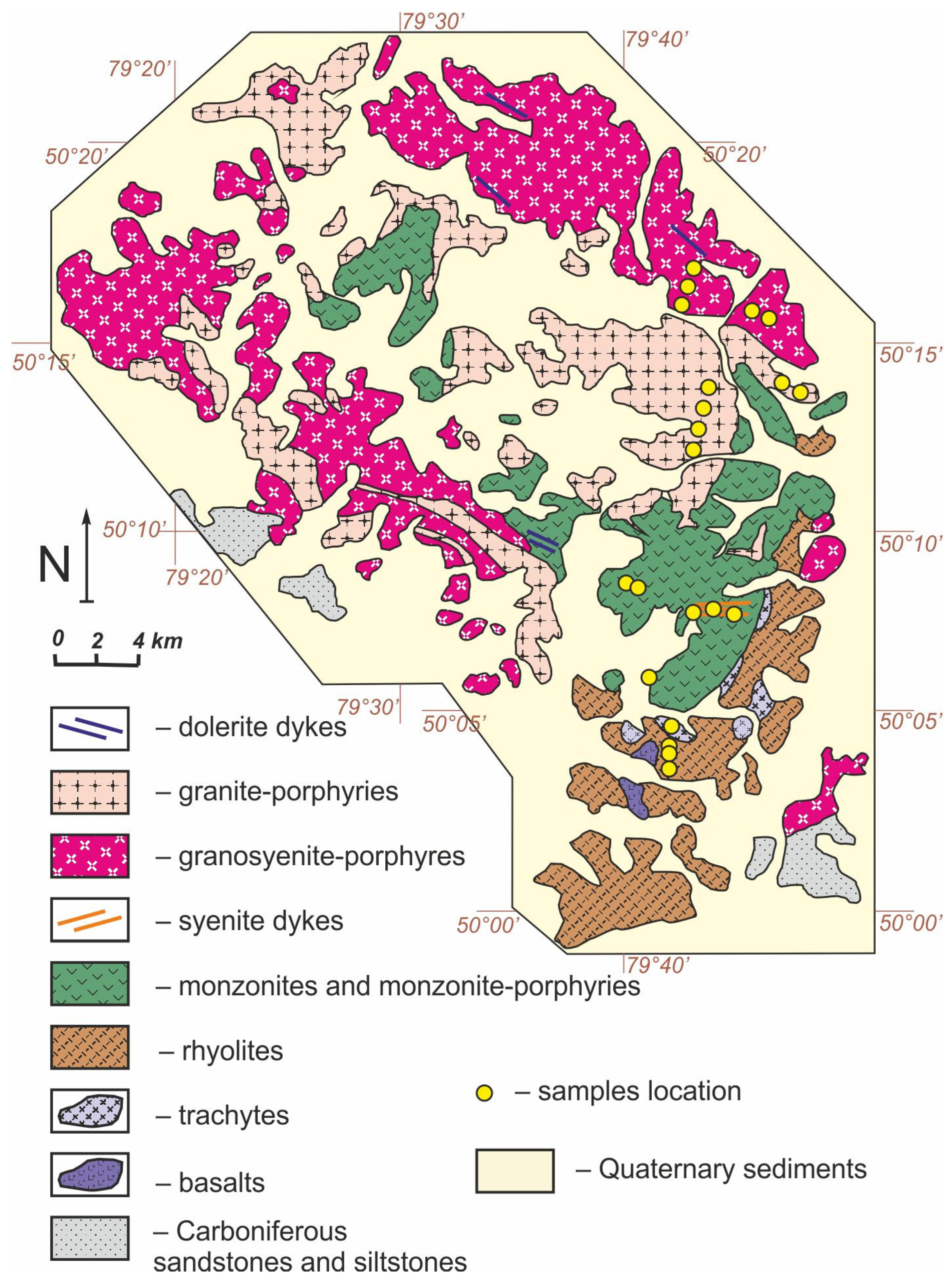

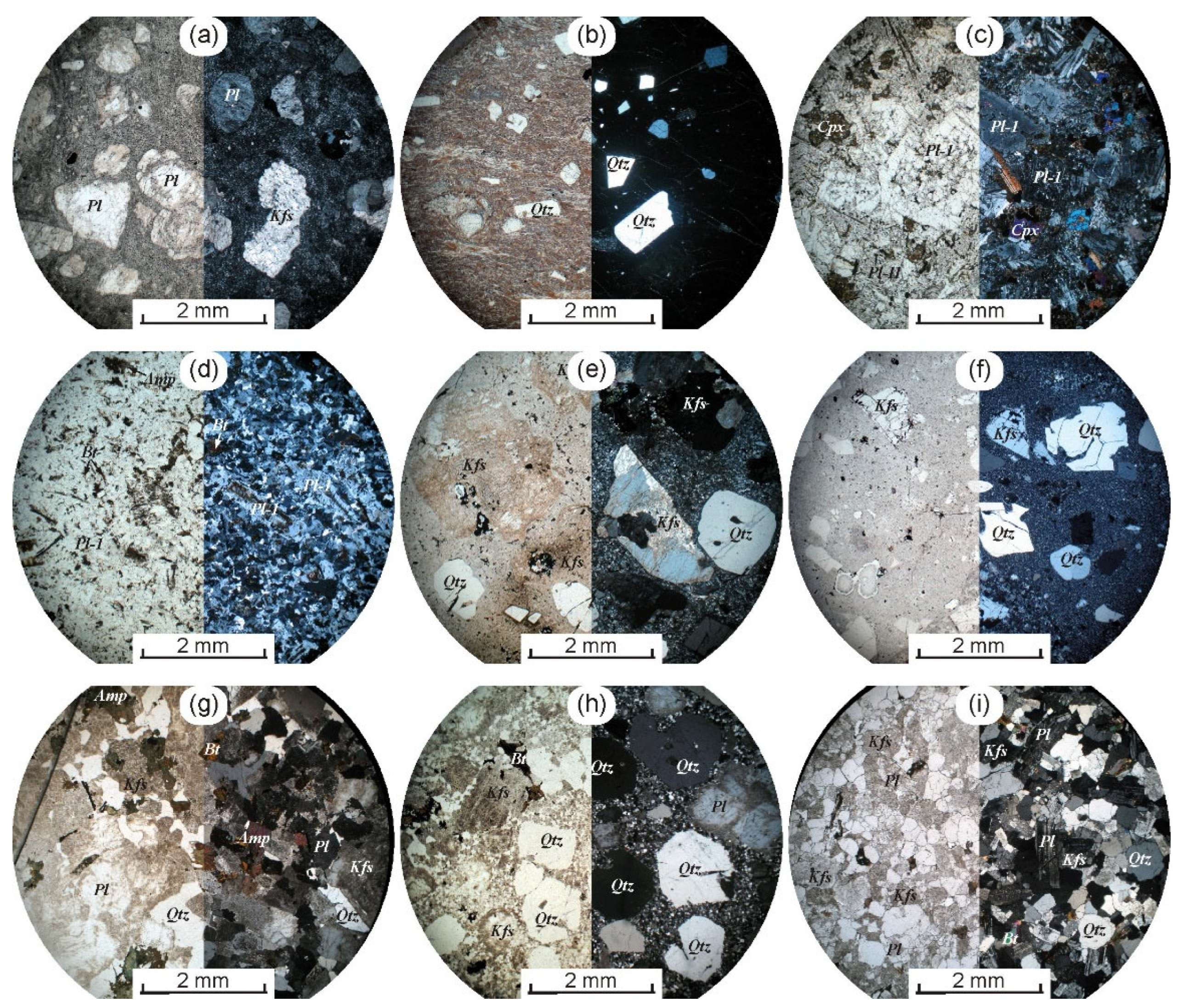

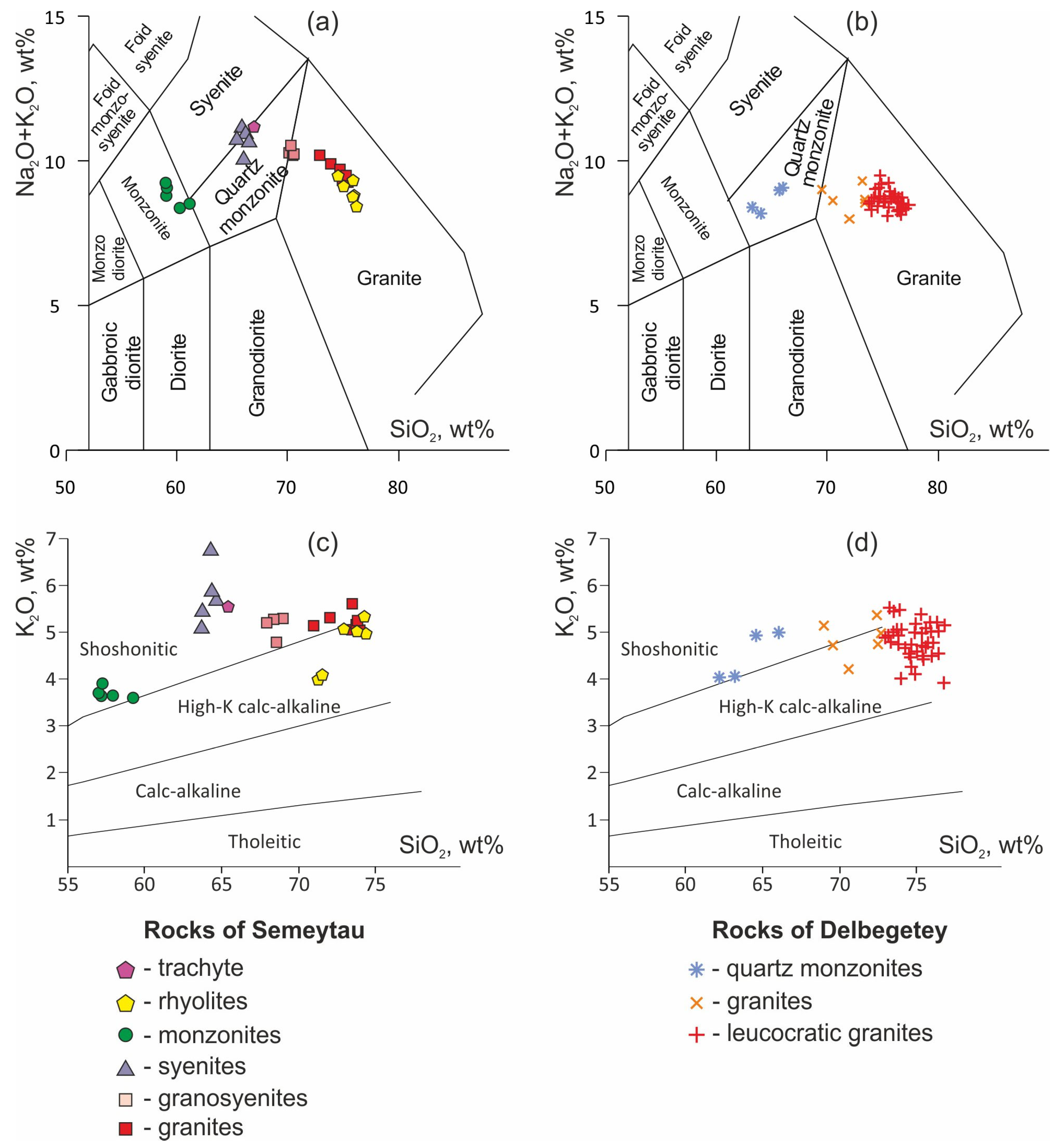
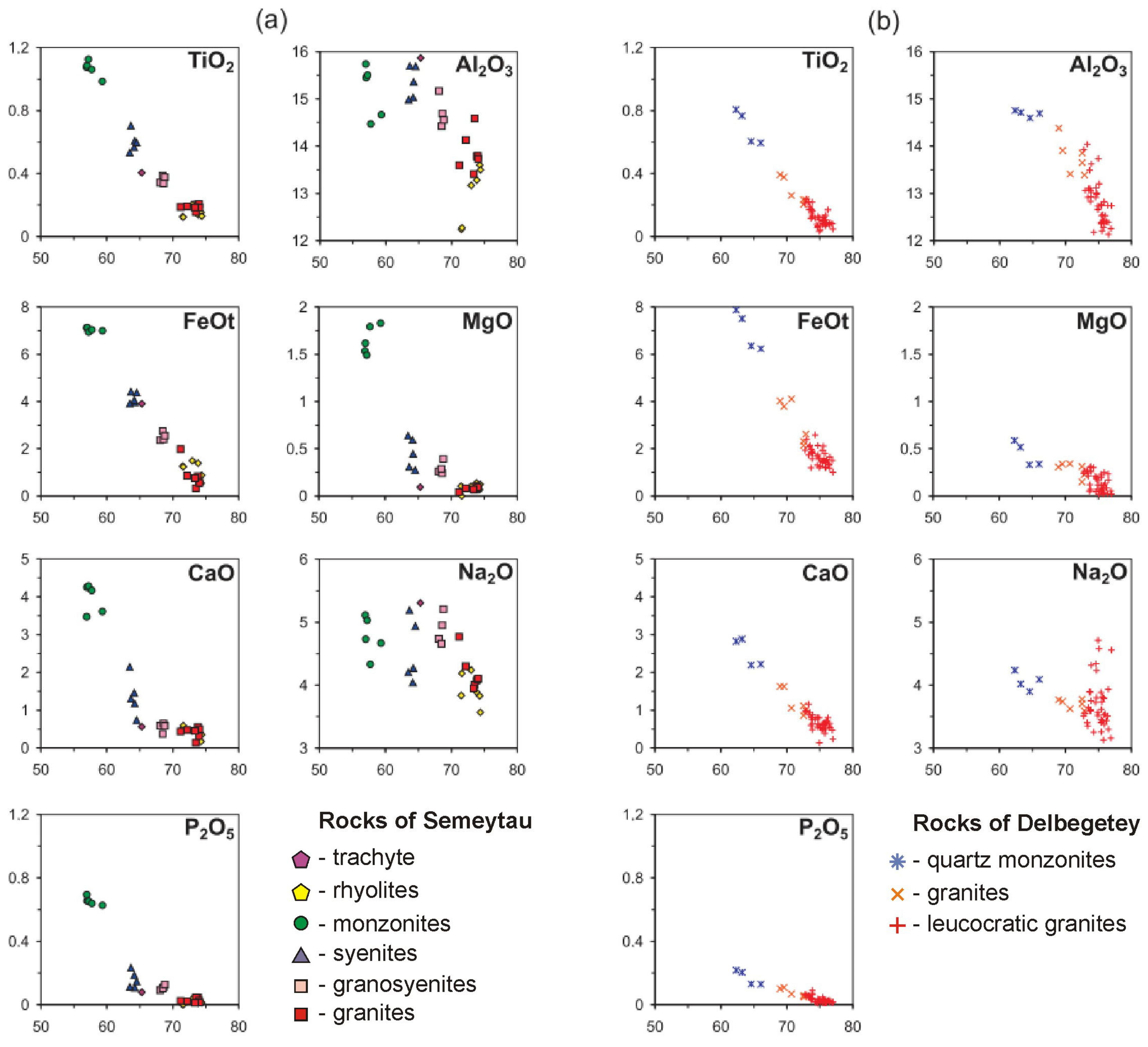

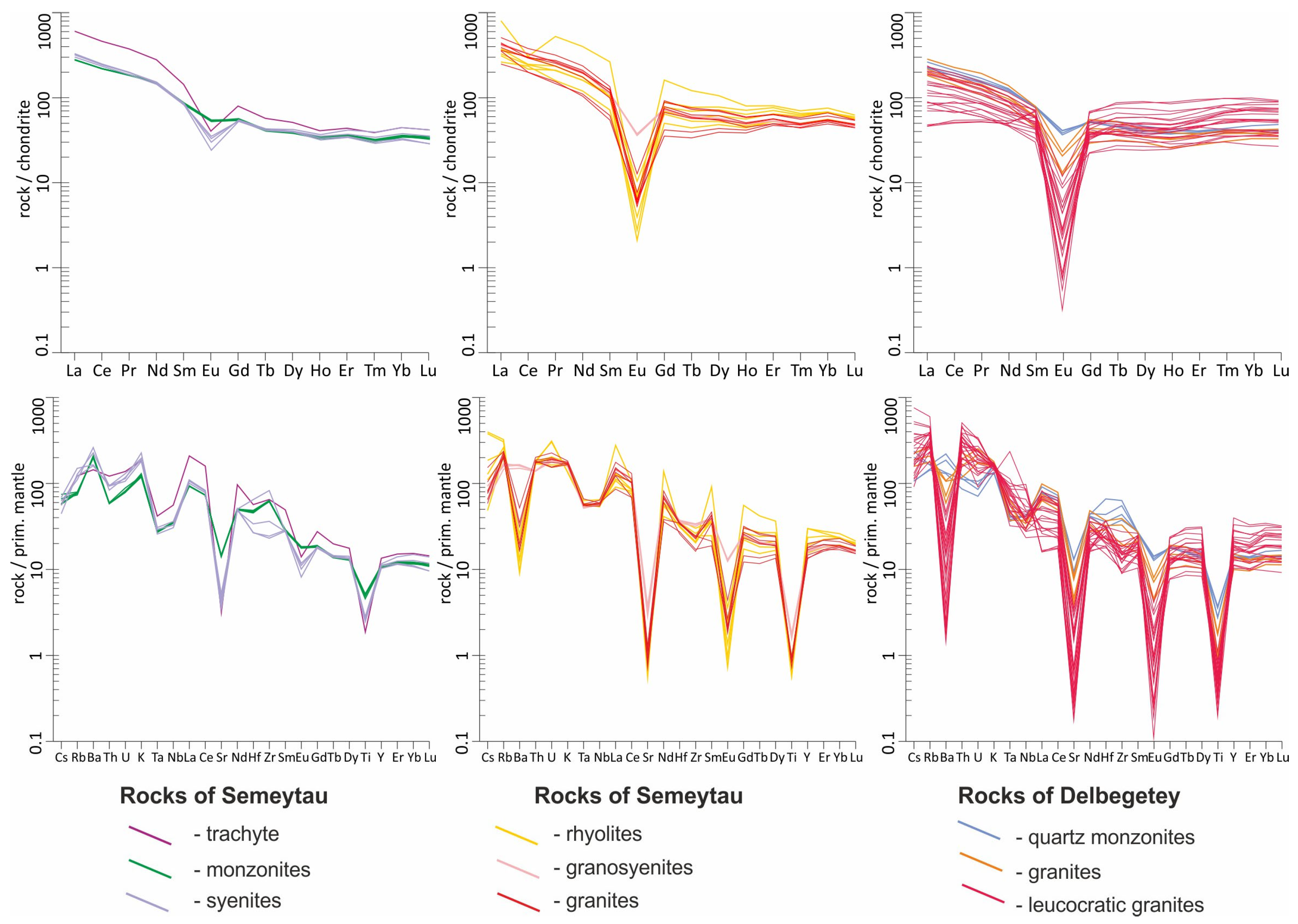

Publisher’s Note: MDPI stays neutral with regard to jurisdictional claims in published maps and institutional affiliations. |
© 2022 by the authors. Licensee MDPI, Basel, Switzerland. This article is an open access article distributed under the terms and conditions of the Creative Commons Attribution (CC BY) license (https://creativecommons.org/licenses/by/4.0/).
Share and Cite
Khromykh, S.V.; Kotler, P.D.; Kulikova, A.V.; Semenova, D.V.; Minnebaev, K.R.; Gareev, B.I.; Batalin, G.A.; Antsiferova, T.N.; Il’icheva, E.A.; Volosov, A.S. Early Triassic Monzonite–Granite Series in Eastern Kazakhstan as a Reflection of Siberian Large Igneous Province Activity. Minerals 2022, 12, 1101. https://doi.org/10.3390/min12091101
Khromykh SV, Kotler PD, Kulikova AV, Semenova DV, Minnebaev KR, Gareev BI, Batalin GA, Antsiferova TN, Il’icheva EA, Volosov AS. Early Triassic Monzonite–Granite Series in Eastern Kazakhstan as a Reflection of Siberian Large Igneous Province Activity. Minerals. 2022; 12(9):1101. https://doi.org/10.3390/min12091101
Chicago/Turabian StyleKhromykh, Sergey V., Pavel D. Kotler, Anna V. Kulikova, Dina V. Semenova, Kamil R. Minnebaev, Bulat I. Gareev, Georgii A. Batalin, Tatiana N. Antsiferova, Ekaterina A. Il’icheva, and Alexey S. Volosov. 2022. "Early Triassic Monzonite–Granite Series in Eastern Kazakhstan as a Reflection of Siberian Large Igneous Province Activity" Minerals 12, no. 9: 1101. https://doi.org/10.3390/min12091101
APA StyleKhromykh, S. V., Kotler, P. D., Kulikova, A. V., Semenova, D. V., Minnebaev, K. R., Gareev, B. I., Batalin, G. A., Antsiferova, T. N., Il’icheva, E. A., & Volosov, A. S. (2022). Early Triassic Monzonite–Granite Series in Eastern Kazakhstan as a Reflection of Siberian Large Igneous Province Activity. Minerals, 12(9), 1101. https://doi.org/10.3390/min12091101







